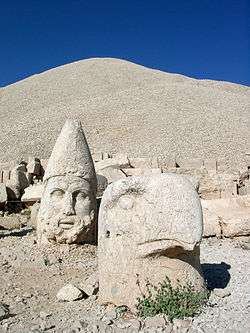Queen of the Mountain
| Queen of the Mountain | |
|---|---|
| Directed by | Martha Goell Lubell |
| Produced by | Martha Goell Lubell |
| Written by |
Sharon Mulally Carol Rosenbaum |
| Music by | Sumi Tonooka |
| Cinematography | Peter Brownscombe |
| Edited by | Sharon Mulally |
Running time | 56 min. |
| Country | United States |
| Language | English |
Queen of the Mountain is a 2005 documentary about Theresa Goell, a middleaged woman who, in 1947, left her husband and son to dig beneath the Sanctuary of Nemrud Dagh. Theresa was fascinated by this shrine to King Antiochus I Theos of Commagene, which had been neglected by previous archaeologists.
Queen of the Mountain tells her story through archival footage, family photographs, oral histories, commentary from Theresa's friends and her own letters. The New York Times said it offered a "strong, rich narrative with visuals to match."
Summary
Theresa’s career as an archaeologist was full of obstacles. She was a woman working in a man’s field, and as a young adult she was also diagnosed with otosclerosis, which meant she would slowly go stone deaf. According to the documentary, it was Theresa’s “bull dog tenacity” that drove her to the Middle East in hopes of discovering buried treasures and ancient secrets.
“People usually walk around a waterfall—I would walk down a waterfall. People usually walk over a bridge—I walked under a bridge,” says Theresa, describing her rambunctious childhood.
Theresa’s father expected his daughter to marry and live a respectable life as a wife and mother. He arranged a marriage for her that she complied with, but soon after, in 1926, while studying at Cambridge, her interest in classical architecture blossomed into a love of archeology. Unhappily married, she divorced her husband, left her son and moved to Jerusalem to study ancient ruins.

The documentary shares anecdotes that shed light on what kind of a woman Theresa was. During World War II, she worked as a draftsman in the Brooklyn naval yard. Her presence was enough to make heads turn. “I was the only woman among 1,200 men,” she says. There was no toilet system for woman so she had to make the long walk across the site to use the Red Cross station. Frustrated, but with a sense of humor, Theresa says, “they thought I was causing a labor problem because every time I walked to the Red Cross station every one of the 1,200 men stopped to whistle at me.”
It was before the war that Theresa learned about Nemrud Dagh, but it wasn’t until 1947 that she was able to travel to the site. With no maps, she set out with only a child to carry her duffel bag. Located in the East section of Turkey, the difficulty of the terrain and obscurity of the location also prevented previous archaeological exploration. King Antiochus’s shrine also slipped through the cracks of interest because it blended classical and oriental traditions. As a result, Classicalists thought it was too oriental and Orientalists thought it too classical.
Theresa proved revolutionary in a number of ways. She recognized the significance of ancient ruins that had been neglected, she insisted her team use modern technological advances; and, perhaps most importantly, she helped pave the way for future female archaeologists.
Reception
The New York Times wrote,
Tess Goell was the kind of American heroine that seemed to exist only in 1930s movies, played byKatharine Hepburn or Rosalind Russell. They were women bravely striding into what was largely believed to be a man's world — flying planes, battling city hall, working in formerly all-male offices or newsrooms. Goell strode into archaeology, a divorced, hearing-impaired Jewish woman amid Muslims in southern Turkey.[1]
Notes
- ↑ Gates, Anita (March 25, 2006), "Examining the Life of Tess Goell, a Pioneering Archaeologist" (PDF), New York Times
See also
References
- "Queen of the Mountain". Women Making Movies. 2005.
- Gates, Anita (March 25, 2006), "Examining the Life of Tess Goell, a Pioneering Archaeologist" (PDF), New York Times
External links
Coordinates: 38°02′07″N 38°45′48″E / 38.03528°N 38.76333°E